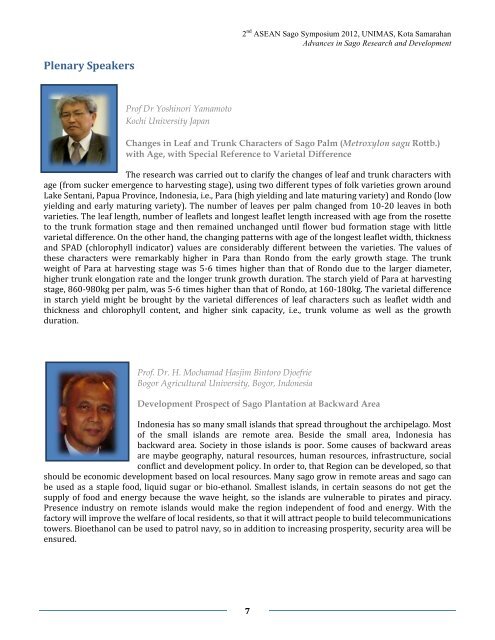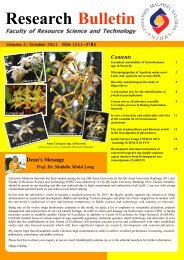2nd ASEAN Sago Symposium 2012, UNIMAS, Kota Samarahan ...
2nd ASEAN Sago Symposium 2012, UNIMAS, Kota Samarahan ...
2nd ASEAN Sago Symposium 2012, UNIMAS, Kota Samarahan ...
Create successful ePaper yourself
Turn your PDF publications into a flip-book with our unique Google optimized e-Paper software.
Plenary Speakers<br />
Prof Dr Yoshinori Yamamoto<br />
Kochi University Japan<br />
2 nd <strong>ASEAN</strong> <strong>Sago</strong> <strong>Symposium</strong> <strong>2012</strong>, <strong>UNIMAS</strong>, <strong>Kota</strong> <strong>Samarahan</strong><br />
Advances in <strong>Sago</strong> Research and Development<br />
Changes in Leaf and Trunk Characters of <strong>Sago</strong> Palm (Metroxylon sagu Rottb.)<br />
with Age, with Special Reference to Varietal Difference<br />
The research was carried out to clarify the changes of leaf and trunk characters with<br />
age (from sucker emergence to harvesting stage), using two different types of folk varieties grown around<br />
Lake Sentani, Papua Province, Indonesia, i.e., Para (high yielding and late maturing variety) and Rondo (low<br />
yielding and early maturing variety). The number of leaves per palm changed from 10-20 leaves in both<br />
varieties. The leaf length, number of leaflets and longest leaflet length increased with age from the rosette<br />
to the trunk formation stage and then remained unchanged until flower bud formation stage with little<br />
varietal difference. On the other hand, the changing patterns with age of the longest leaflet width, thickness<br />
and SPAD (chlorophyll indicator) values are considerably different between the varieties. The values of<br />
these characters were remarkably higher in Para than Rondo from the early growth stage. The trunk<br />
weight of Para at harvesting stage was 5-6 times higher than that of Rondo due to the larger diameter,<br />
higher trunk elongation rate and the longer trunk growth duration. The starch yield of Para at harvesting<br />
stage, 860-980kg per palm, was 5-6 times higher than that of Rondo, at 160-180kg. The varietal difference<br />
in starch yield might be brought by the varietal differences of leaf characters such as leaflet width and<br />
thickness and chlorophyll content, and higher sink capacity, i.e., trunk volume as well as the growth<br />
duration.<br />
Prof. Dr. H. Mochamad Hasjim Bintoro Djoefrie<br />
Bogor Agricultural University, Bogor, Indonesia<br />
Development Prospect of <strong>Sago</strong> Plantation at Backward Area<br />
Indonesia has so many small islands that spread throughout the archipelago. Most<br />
of the small islands are remote area. Beside the small area, Indonesia has<br />
backward area. Society in those islands is poor. Some causes of backward areas<br />
are maybe geography, natural resources, human resources, infrastructure, social<br />
conflict and development policy. In order to, that Region can be developed, so that<br />
should be economic development based on local resources. Many sago grow in remote areas and sago can<br />
be used as a staple food, liquid sugar or bio-ethanol. Smallest islands, in certain seasons do not get the<br />
supply of food and energy because the wave height, so the islands are vulnerable to pirates and piracy.<br />
Presence industry on remote islands would make the region independent of food and energy. With the<br />
factory will improve the welfare of local residents, so that it will attract people to build telecommunications<br />
towers. Bioethanol can be used to patrol navy, so in addition to increasing prosperity, security area will be<br />
ensured.<br />
7



